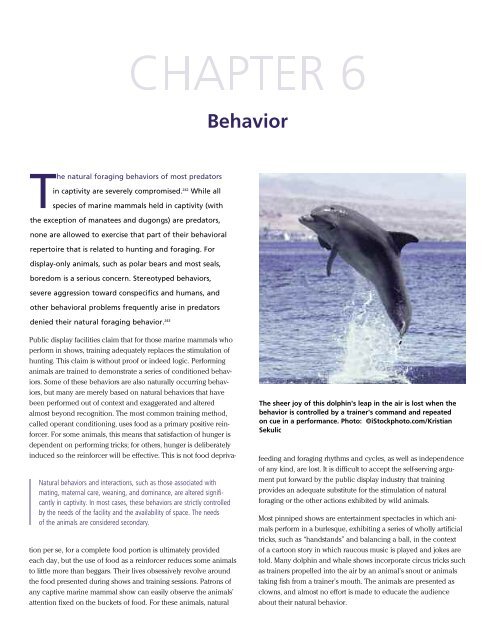The Case against Marine Mammals in Captivity - The Humane ...
The Case against Marine Mammals in Captivity - The Humane ...
The Case against Marine Mammals in Captivity - The Humane ...
- No tags were found...
Create successful ePaper yourself
Turn your PDF publications into a flip-book with our unique Google optimized e-Paper software.
Behavior<strong>The</strong> natural forag<strong>in</strong>g behaviors of most predators<strong>in</strong> captivity are severely compromised. 242 While allspecies of mar<strong>in</strong>e mammals held <strong>in</strong> captivity (withthe exception of manatees and dugongs) are predators,none are allowed to exercise that part of their behavioralrepertoire that is related to hunt<strong>in</strong>g and forag<strong>in</strong>g. Fordisplay-only animals, such as polar bears and most seals,boredom is a serious concern. Stereotyped behaviors,severe aggression toward conspecifics and humans, andother behavioral problems frequently arise <strong>in</strong> predatorsdenied their natural forag<strong>in</strong>g behavior. 243Natural behaviors and <strong>in</strong>teractions, such as those associated withmat<strong>in</strong>g, maternal care, wean<strong>in</strong>g, and dom<strong>in</strong>ance, are altered significantly<strong>in</strong> captivity. In most cases, these behaviors are strictly controlledby the needs of the facility and the availability of space. <strong>The</strong> needsof the animals are considered secondary.Public display facilities claim that for those mar<strong>in</strong>e mammals whoperform <strong>in</strong> shows, tra<strong>in</strong><strong>in</strong>g adequately replaces the stimulation ofhunt<strong>in</strong>g. This claim is without proof or <strong>in</strong>deed logic. Perform<strong>in</strong>ganimals are tra<strong>in</strong>ed to demonstrate a series of conditioned behaviors.Some of these behaviors are also naturally occurr<strong>in</strong>g behaviors,but many are merely based on natural behaviors that havebeen performed out of context and exaggerated and alteredalmost beyond recognition. <strong>The</strong> most common tra<strong>in</strong><strong>in</strong>g method,called operant condition<strong>in</strong>g, uses food as a primary positive re<strong>in</strong>forcer.For some animals, this means that satisfaction of hunger isdependent on perform<strong>in</strong>g tricks; for others, hunger is deliberately<strong>in</strong>duced so the re<strong>in</strong>forcer will be effective. This is not food deprivationper se, for a complete food portion is ultimately providedeach day, but the use of food as a re<strong>in</strong>forcer reduces some animalsto little more than beggars. <strong>The</strong>ir lives obsessively revolve aroundthe food presented dur<strong>in</strong>g shows and tra<strong>in</strong><strong>in</strong>g sessions. Patrons ofany captive mar<strong>in</strong>e mammal show can easily observe the animals’attention fixed on the buckets of food. For these animals, natural<strong>The</strong> sheer joy of this dolph<strong>in</strong>'s leap <strong>in</strong> the air is lost when thebehavior is controlled by a tra<strong>in</strong>er's command and repeatedon cue <strong>in</strong> a performance. Photo: ©iStockphoto.com/KristianSekulicfeed<strong>in</strong>g and forag<strong>in</strong>g rhythms and cycles, as well as <strong>in</strong>dependenceof any k<strong>in</strong>d, are lost. It is difficult to accept the self-serv<strong>in</strong>g argumentput forward by the public display <strong>in</strong>dustry that tra<strong>in</strong><strong>in</strong>gprovides an adequate substitute for the stimulation of naturalforag<strong>in</strong>g or the other actions exhibited by wild animals.Most p<strong>in</strong>niped shows are enterta<strong>in</strong>ment spectacles <strong>in</strong> which animalsperform <strong>in</strong> a burlesque, exhibit<strong>in</strong>g a series of wholly artificialtricks, such as “handstands” and balanc<strong>in</strong>g a ball, <strong>in</strong> the contextof a cartoon story <strong>in</strong> which raucous music is played and jokes aretold. Many dolph<strong>in</strong> and whale shows <strong>in</strong>corporate circus tricks suchas tra<strong>in</strong>ers propelled <strong>in</strong>to the air by an animal’s snout or animalstak<strong>in</strong>g fish from a tra<strong>in</strong>er’s mouth. <strong>The</strong> animals are presented asclowns, and almost no effort is made to educate the audienceabout their natural behavior.
















